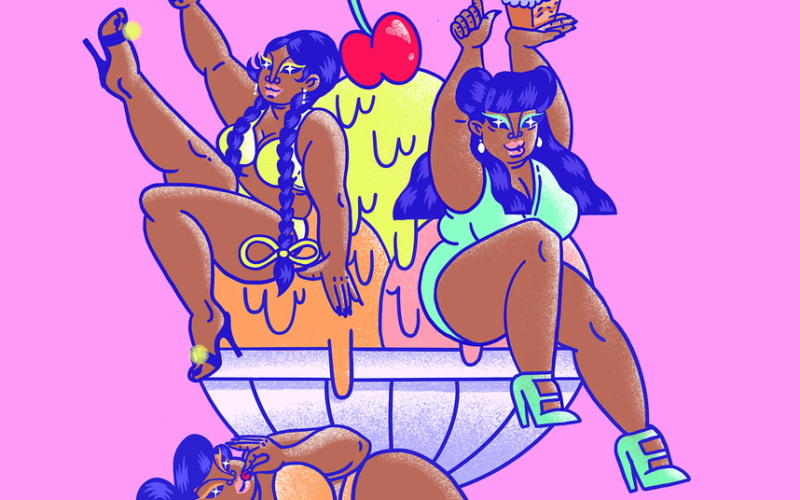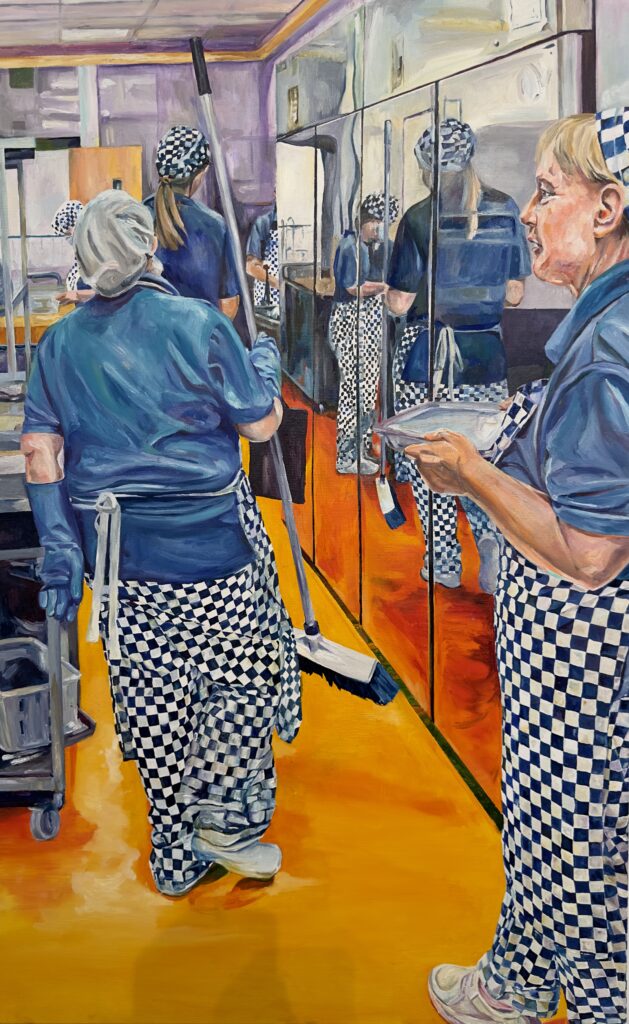
Artist Ravinder’s Journey from Cancer patient to Art and Healing


Ravinder Ruprai is a wonderful artist from Hamilton who beautifully blends her South Asian roots with abstract art. In this interview, she shares her personal journey, discussing her return to painting after a ten-year break and her battle with cancer. She explains how these experiences have made her art deeply personal, focusing on themes like trauma, healing, and the mind-body connection. Ravinder also opens up about her cultural background and how it shapes her role in the local art scene. She reflects on her early life and her parents’ textile business and how these experiences are woven into her work. This conversation gives us a glimpse into the depth of Ravinder’s creative process and her commitment to telling authentic, vulnerable stories through her art.
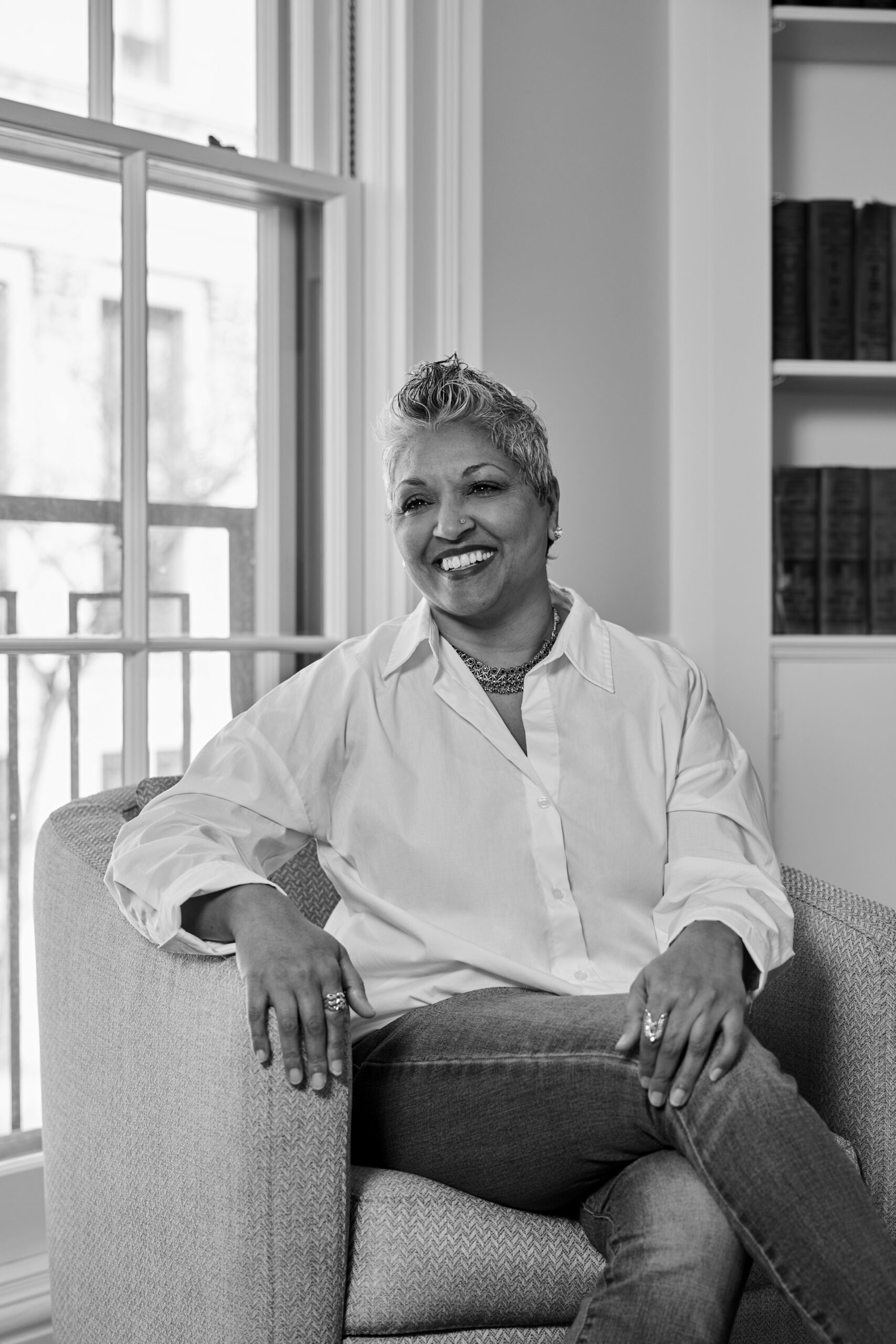
Ravinder Ruprai has a BFA in Honours from McMaster University. Upon graduating, Ravinder immersed herself in the arts community in Hamilton, including regularly exhibiting her work and volunteering on art committees. She worked at the Art Gallery of Hamilton from 1997—1999, broadening her exposure to national artists, public collections, and art education. Ravinder returned to painting and art-making after a ten-year unplanned hiatus (2003—2013). During this time, and moving forward, she has devoted herself to raising three children and recovering from an aggressive form of cancer.
Ravinder’s unique voice is only one of few South Asian women producing art in Hamilton. Her work is autobiographical and is often series-based. While working under the larger theme of the mind/body connection, Ravinder has spent the last few years focussing on and moving towards wholeness: mind, body, and spirit. Her work explores various aspects of the mind/body connection—trauma and energy medicine, meditation and mental health, memory and remembrance, and neuroplasticity. Ravinder’s work addresses dysfunctional family systems, misogyny, racism, displacement as seen through the eyes of an immigrant, and what it means to be a woman of color. Ravinder is largely an abstract painter who works primarily in acrylics on canvas and paper. Her paintings often explore dichotomies between micro, macroscopic, biological, and geological forms. She uses layers of pattern and texture drawn from her South Asian heritage, combined with nature, the body, and the landscape. Her use of color is rich, bold, and dramatic. Her work post-cancer includes the circle—a symbol of totality and wholeness, of perfection, of sacredness. The artist has recently worked with fabrics and fiber-based materials, creating more sculptural works. These are represented in Ravinder’s work titled The Gold Box Series, an ongoing series since 2021. This series invites the viewer into the artist’s stories as a trauma survivor. The gold borders of each shadow box isolate fragments of a personal reflection of the intersectional experience.
Ravinder’s use of an intimate voice and scale captures invisible systems—racial, patriarchal, systemic…She isolates and integrates—painting, braiding, writing, gilding, and framing in the representation of those systems as they are prescribed both upon the body and in the body. Ravinder is a first-generation immigrant born in England who immigrated to Canada in 1975. Her parents owned their own textile manufacturing factories in both countries. Her use of pattern and ‘textiles’ echoes this backdrop. Ravinder also uses ‘stitching’ in her paintings and fibre works, referencing both her childhood environment and also as a recognition of the extreme medical procedures she has undergone
1. Ravinder, you’ve faced many personal challenges, especially during your cancer journey. How has this experience changed how you create art and the stories you tell?
Being diagnosed with cancer changed every aspect of my life—for me and my family. When I was diagnosed in 2012, I hadn’t painted for ten years! It wasn’t a planned hiatus. I was raising three children and working 10-12 hour rotating shifts. My art practice had to be put on hold. I promised myself that I would return to painting if I survived. Before this diagnosis, I was trying to tell stories from a more general point of view. The stories were still issues that pertained to being a South Asian woman—topics like oppression, arranged marriages, domestic violence, subjugation, etc.—but I needed to distance myself from these issues, probably to protect myself. These were topics that I did not see being discussed in school and the larger art community at that time. Now, the stories are more transparent and nuanced. They are autobiographical, by and large. They are stories of my authentic self, and I am entirely vulnerable.

2. Your art blends your South Asian roots with nature and the human body. How do you bring these influences together in your abstract paintings, and what do they mean to you?
I love colour! I love the saturated color and use of patterns in Indian textiles. Throughout my life, I have been obsessed with the question ‘why?’ I needed to know why things presented themselves in my life the way they were. I started looking for patterns—mental, behavioural, physical. I was introduced to energy medicine. I was looking at the notion of wholeness, and this included everything internal—of the body and all things external, including my natural environment. The paintings are like abstract landscapes. I like to play with the scales between micro and macro and reference the biological. They are direct references to the body and nature and the balance and harmony I strive for.

I like to play with the scales between micro and macro and reference the biological. They are direct references to the body and nature and the balance and harmony I am striving for in life.
Ravinder Ruprai
3. The Gold Box Series is such a unique project with its mix of materials and techniques. What led you to start making more sculptural works, and how do these pieces reflect your experiences with trauma?
I believe in counseling and therapy to cope with life’s challenges and experiences. I have always sought greater awareness and understanding of connectivity and relationality. The pandemic really rocked the foundation for everyone around the world. I know it was an unmooring experience for most people, and the decline in mental health was astonishing globally. It was a time of great isolation and immense creative focus. I have a compromised immune system, and my kids were going to be attending three different schools. We decided it was best for our family to have the kids do remote learning. My studio became my refuge during this eighteen-month period. And, after many years of searching, in 2021, I finally found the right therapist who I began the journey of trauma counseling with. Trauma counseling made the notion of compartmentalization crystal clear. The Gold Box Series began during this period. Each box represents an embodied, experiential memory or related memories where the present is influenced by the past and the grief that we carry. With the urgent need to release the grief, I found I could experience these memories as gifts—gifts of suffering, knowing and acknowledgement, gifts of mercy. I came to the beautiful and freeing realization that deep gratitude can exist in this grief. These things can co-exist. We are capable of transformation. We can take our grief and turn it into wisdom. In a previous series of work, I reference Audubon’s butterflies and being ‘pinned’ like they were. I was drawn to the idea of pinning moments of trauma and grief in boxes like a scientist or researcher would. Compartmentalization helps us disassociate and detach and acts as a coping mechanism around difficult experiences and situations. The boxes allow for safe scrutiny.
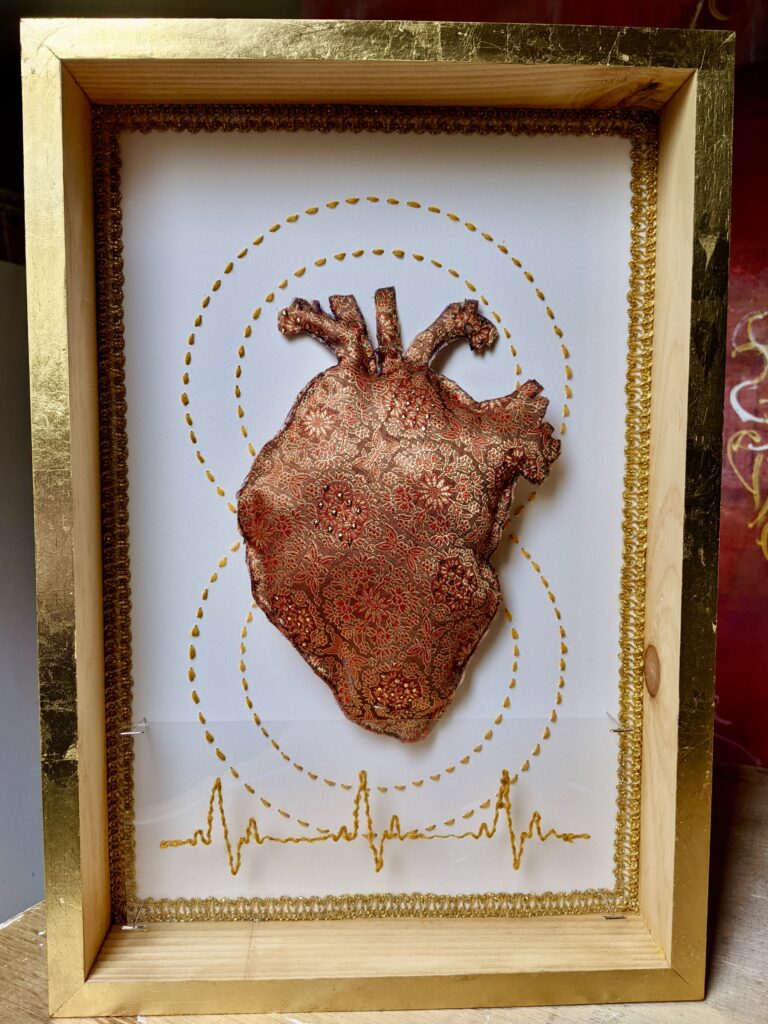
4. As one of the few South Asian women artists in Hamilton, how has your cultural background shaped your view and role in the local art scene?
I was among the few artists of colour in the fine arts program during school. And there were no instructors of colour. It was an isolating experience in that sense. And it continues to be in the larger art community I am part of. After I graduated in 1993, I immersed myself in the local art scene. And while there was a strong presence of female artists, they were all older, white women. It was not an especially welcoming environment. Again, I felt like I was working in a vacuum. When an artist has a unique voice, they provide a different perspective and context for that perspective. Still, I worked hard to exhibit and establish myself as an artist here. Re-emerging after a ten-year hiatus, and as an older woman, has also been difficult. The art community that I had known no longer existed. This city has had a large influx of artists from other cities. Re-establishing myself amongst artists I do not know has been challenging. This has definitely been made easier with social media apps like Instagram. For that, I am truly grateful. And although I have been showing up regularly over the past eight years, it has been an arduous process, and I remain on the margins. Having said that, I would be remiss not to mention that the Art Gallery of Hamilton recently acquired two of the gold boxes for their permanent collection. And, there are a few more artists of colour here. I do try to connect with them when I can.
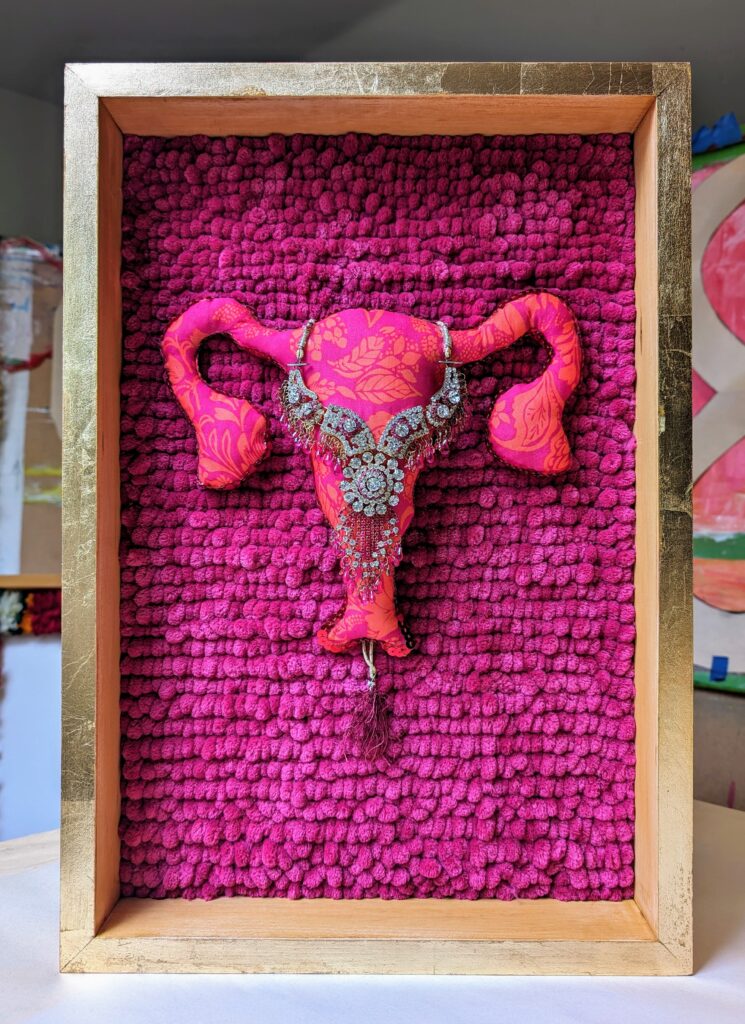
Art acts as an interface between the artist and the viewer. I am always interested in what the viewers themselves bring to the work.
Ravinder Ruprai
5. Your work explores trauma, meditation, and mental health topics. How do you translate these complex ideas into visual art, and what do you hope people feel or think when they see your work?
I love using colour to evoke mood, especially when I am painting. I also reference the colours associated with the Chakra systems and their affiliated stones. And like most artists, I have created my own symbology and language. I often use the circle to represent wholeness, completeness, sacredness, and totality. The braid is also in my lexicon of images. I use it as a way to weave the mind, body, and spirit together, as well as the past, present, and future. Gold leaf ravens represent the spiritual and the possibility of transformation. I use the infinity symbol and telomeres. Yes, the subject matter can be intense and heavy at times. I really hope that people can understand the work on many different levels. A visceral response is always fantastic, but I hope people walk away with a deeper understanding of the human condition. We are complex beings and live multi-faceted lives, but we have more in common with each other than not. It’s also not always necessary for viewers to see a full ‘translation’ of what I am trying to achieve. Art acts as an interface between the artist and the viewer. I am always interested in what the viewers themselves bring to the work.
6. You use stitching in your art, which connects to your parents’ textile business and your past. How has this part of your childhood influenced your creative process and the stories you tell through your art?
I had a tumultuous childhood. I grew up caught between two worlds. We were immigrants living in smaller, all-white towns where there were no communities of other South Asian families. We had no family here. Eventually, my parents met other families, but they lived in other areas. My parents’ textile business was important because it provided work for many South Asian newcomers who wouldn’t have been able to find work elsewhere—women who did not have work histories or spoke little to no English. I grew up learning many aspects of the textile industry. We had these gigantic knitting machines. Each machine used 70+ spools of yarn that were suspended on racks and fed through six-inch long needles. These machines created bolts of fabric that were then sent away to be dyed and properly stretched. The din of the machines blocked out most other sounds, so it became easy to lose oneself and detach. The knitting process was mesmerizing and calming to watch. I am really drawn to the idea of all these separate threads coming together so neatly and completely, creating a wholeness. We are the sum of our parts. But I took it further into healing by referencing stitching as a surgical process in closing wounds and repairing ourselves physically. My scar from my cancer surgery is 10 1/4 inches long and spans across my torso. I am reminded every day of what I have survived and all that I have come through. Through art-making, I can reconnect to my childhood and repair what I can. I strive constantly for renewal and transformation, to essentially become metamorphic.

Ravinder’s story shows how powerful and healing art can be. By blending her South Asian heritage with her personal experiences, she creates meaningful art that touches on identity, trauma, and healing. Her dedication to honesty and vulnerability in her work inspires us to accept our true selves and find healing through our journeys. To learn more about Ravinder, click the following links to visit her profile.












